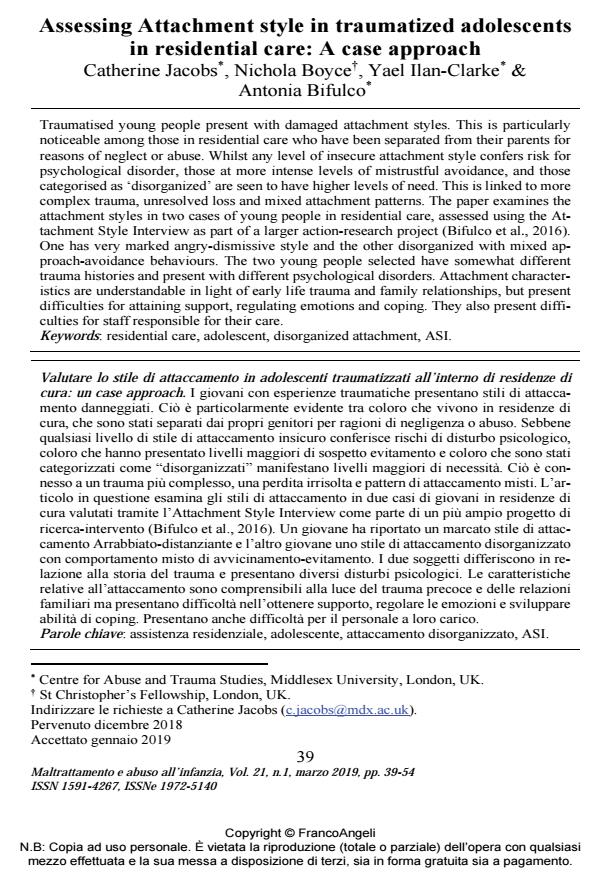Assessing Attachment style in traumatized adolescents in residential care: A case approach
Journal title MALTRATTAMENTO E ABUSO ALL’INFANZIA
Author/s Catherine Jacobs, Nichola Boyce, Yael Ilan-Clarke, Antonia Bifulco
Publishing Year 2019 Issue 2019/1
Language English Pages 16 P. 39-54 File size 197 KB
DOI 10.3280/MAL2019-001004
DOI is like a bar code for intellectual property: to have more infomation
click here
Below, you can see the article first page
If you want to buy this article in PDF format, you can do it, following the instructions to buy download credits

FrancoAngeli is member of Publishers International Linking Association, Inc (PILA), a not-for-profit association which run the CrossRef service enabling links to and from online scholarly content.
Traumatised young people present with damaged attachment styles. This is particularly no-ticeable among those in residential care who have been separated from their parents for rea-sons of neglect or abuse. Whilst any level of insecure attachment style confers risk for psy-chological disorder, those at more intense levels of mistrustful avoidance, and those catego-rised as ‘disorganized’ are seen to have higher levels of need. This is linked to more com-plex trauma, unresolved loss and mixed attachment patterns. The paper examines the at-tachment styles in two cases of young people in residential care, assessed using the At-tachment Style Interview as part of a larger action-research project (Bifulco et al., 2016). One has very marked angry-dismissive style and the other disorganized with mixed ap-proach-avoidance behaviours. The two young people selected have somewhat different trauma histories and present with different psychological disorders. Attachment characteris-tics are understandable in light of early life trauma and family relationships, but present dif-ficulties for attaining support, regulating emotions and coping. They also present difficulties for staff responsible for their care.
Keywords: Residential care, adolescent, disorganized attachment, ASI.
- Understanding trauma in children and young people in the school setting Ruth Spence, Lisa Kagan, Moja Kljakovic, Antonia Bifulco, in Educational and Child Psychology /2021 pp.87
DOI: 10.53841/bpsecp.2021.38.1.87 - Incidenza e caratteristiche dei minori accolti in Strutture Residenziali in Regione Lombardia Sarah Miragoli, Ciro Cascone, Francesca Sgrò, Vittoria Badino, Luca Milani, in MALTRATTAMENTO E ABUSO ALL'INFANZIA 3/2024 pp.67
DOI: 10.3280/MAL2023-003005
Catherine Jacobs, Nichola Boyce, Yael Ilan-Clarke, Antonia Bifulco, Assessing Attachment style in traumatized adolescents in residential care: A case approach in "MALTRATTAMENTO E ABUSO ALL’INFANZIA" 1/2019, pp 39-54, DOI: 10.3280/MAL2019-001004